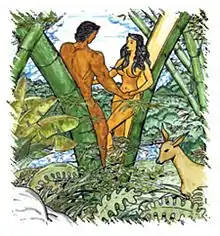List of Philippine mythological creatures
A host of mythological creatures occur in the mythologies from the Philippines. Philippine mythological creatures are the mythological beasts, monsters, and enchanted beings of more than 140 ethnic groups in the Philippines. Each ethnic people has their own unique set of belief systems, which includes the belief in various mythological creatures. The list does not include figures such as gods, goddesses, deities, and heroes; for these, see List of Philippine mythological figures.
 |
| Mythological figures |
|---|
| Mythological creatures |
| Anito |
|
|
General terms
Some mythological creatures, aside from their specific name, are also referred through a generic term which encompasses other similar mythological creatures. Some of these terms include:
- Aswang: bracket term for shape-shifting creatures that have a variety of forms, such as the blood-sucking vampire, the self-segmenting viscera sucker, the man-eating weredog, the vindictive or evil-eye witch, and the carrion-eating ghoul[1]
- Duwende: bracket term for small magical beings of the land[2]
- Engkanto: bracket term for highly-attractive enchanted human-like environmental beings, usually exuding the scent of flowers and having no philthrum[3]
- Higante: bracket term for giant humanoid land creatures[4]
- Sirena: bracket term for water creatures with a humanoid upper body and the body of a fish from waist down similar to merfolks[5]
Most creatures originating from Philippine mythology, however, are not under any specific bracket term.
Creatures of the soil
- Agta
- Alan
- Amalanhig
- Amomongo
- Anggitay
- Bal-Bal
- Batibat
- Berbalang
- Bungisngis: one-eyed giant, purported to dwell in Meluz, Orion, Bataan, and Cebu; described as always laughing.[6]
- Busaw
- Dalaketnon
- Diwata: (from Sanskrit devata, "gods"), engkantada (from Spanish encantada, "enchantress, charmed") or engkanto (from Spanish encanto, "spell, incantation, charm") are gods and goddesses below the supreme deity or deities; some are similar to dryads who guard natural creations such as forests, seas, mountains, land and air;[7] fair-skinned, good-looking and, sometimes, blonde-haired.[8] reside in large trees, such as acacia and balete, and tend to be resentful of humanity's intrusion into their realm[9]
- Dwende: goblins, hobgoblins, elves or dwarfs (Spanish: duende "goblin, elf, charm" < "duen de (casa)", owner of the house); little creatures who provide good fortune or foretell an ominous fate to people.[10]
- Kapre: muscular tree giants described as being a tall (7 to 9 ft), big, black, terrifying, and hairy[11]
- Mambabarang: witches who utilize insects to do their bidding[12]
- Mangkukulam: bruha (from Spanish: bruja, "witch") are witches, wizards, bruho (Spanish:brujo, "wizard, male witch"), or sorcerers who cast evil spells to humans; also called manggagaway[13]
- Multo
- Nuno sa punso: (literally, goblin of the mound) goblins or elves who live within mysterious lumps of soil (ant hills); provide a person who steps on their shelter with good luck or misfortune[14]
- Pugot
- Santelmo
- Sarangay
- Sigbin
- Tikbalang: lurk in the mountains and forests; tall, bony humanoid creature with the head and hooves of a horse and disproportionately long limbs, to the point that its knees reach above its head when it squats down[15]
- Tiyanak
Creatures of the water
Creatures of the air
- Bakunawa
- Garuda
- Manananggal: derived from the word, tanggal, which means "to separate" because of their ability to separate from their lower body part[17]
- Manaul
- Minokawa
- Sarimanok: papanok in its feminine form, is a legendary multi-colored bird or chicken[18]
- Tigmamanukan
- Wakwak
References
- The Aswang Complex in Philippine Folklore, Maximo Ramos, 1990, Phoenix Publishing
- https://www.bbc.com/future/article/20200728-the-mythical-creatures-that-protect-the-philippines
- https://pop.inquirer.net/76529/what-the-folktales-philippine-mythical-creatures-you-need-to-know
- https://www.philstar.com/lifestyle/for-men/2010/10/27/624110/monsters-my-mind
- Philippine Demonological Legends and Their Cultural Bearings, Maximo Ramos, Phoenix Publishing 1990
- Ramos, Maximo D. (1990) [1971]. Creatures of Philippine Lower Mythology. Quezon: Phoenix Publishing. p. 76. ISBN 971-06-0691-3.
- Tagalog-English Dictionary by Leo James English, Congregation of the Most Holy Redeemer, Manila, distributed by National Book Store, 1583 pages, ISBN 971-91055-0-X
- Ramos, Maximo (1971). Creatures of Philippine Lower Mythology. Philippines: University of the Philippines Press. p. 54.
- Ramos, Maximo (1971). Creatures of Philippine Lower Mythology. Philippines: University of the Philippines Press. p. 54.
- Tagalog-English Dictionary by Leo James English, Congregation of the Most Holy Redeemer, Manila, distributed by National Book Store, 1583 pages, ISBN 971-91055-0-X
- Jocano, F. Landa (1983). The Hiligaynon: An Ethnography of Family and Community Life in Western Bisayas Region. Asian Center, University of the Philippines. p. 254. Retrieved 23 May 2017.
- https://lifestyle.inquirer.net/343988/of-barang-and-mananambal-on-siquijor-island/
- Tagalog-English Dictionary by Leo James English, Congregation of the Most Holy Redeemer, Manila, distributed by National Book Store, 1583 pages, ISBN 971-91055-0-X
- Tagalog-English Dictionary by Leo James English, Congregation of the Most Holy Redeemer, Manila, distributed by National Book Store, 1583 pages, ISBN 971-91055-0-X
- Eugenio, Damiana L. (2008). Philippine Folk Literature An Anthology. University of the Philippines Press. p. 247. ISBN 978-971-542-536-0. Retrieved 2009-05-08.
- Tagalog-English Dictionary by Leo James English, Congregation of the Most Holy Redeemer, Manila, distributed by National Book Store, 1583 pages, ISBN 971-91055-0-X
- Tagalog-English Dictionary by Leo James English, Congregation of the Most Holy Redeemer, Manila, distributed by National Book Store, 1583 pages, ISBN 971-91055-0-X
- Peralta, Jesus T. (1980). "Southwestern Philippine Art". Anthropological Papers (National Museum (Philippines)) (7): 32–34.